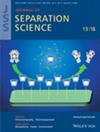Preparation and Application of Weak Cation Exchange Resin Based on Thiol Click Reaction
Abstract
Using poly(styrene-divinylbenzene) microspheres as stationary phase matrix and mercaptosuccinic acid as a modifier, a new weak cation exchange resin was synthesized by thiol click reaction. The conditions for thiol-chlorine click reaction and thiol-alkene click reaction were optimized. The surface morphology and chemical composition of the modified microspheres were characterized by scanning electron microscopy, Fourier-transform infrared spectroscopy, and an elemental analyzer. The stationary phase can achieve the separation of six common cations within 25 min. A homemade weak cation chromatographic column was used to determine the impurities of Na+ and K+ and the content of tetramethylammonium ions in tetramethylammonium hydroxide samples. The method showed a good linear correlation in the range of 0.1–500.0 mg/L with correlation coefficients of 0.9998–0.9999, and the limits of detection (signal-to-noise ratio ≥ 3) were 0.01–0.20 mg/L. The intra-day relative standard deviations (RSDs) were in the range of 1.1%–4.4%, and the inter-day RSDs were in the range of 0.8%–14.8%. The spiked recoveries were in the range of 91.92%–119.86%. The results showed that the prepared stationary phase exhibited effective separation ability and good reproducibility, which was suitable for the analysis of the impurities of Na+, K+, and the content of tetramethylammonium in the tetramethylammonium reagents.

 求助内容:
求助内容: 应助结果提醒方式:
应助结果提醒方式:


